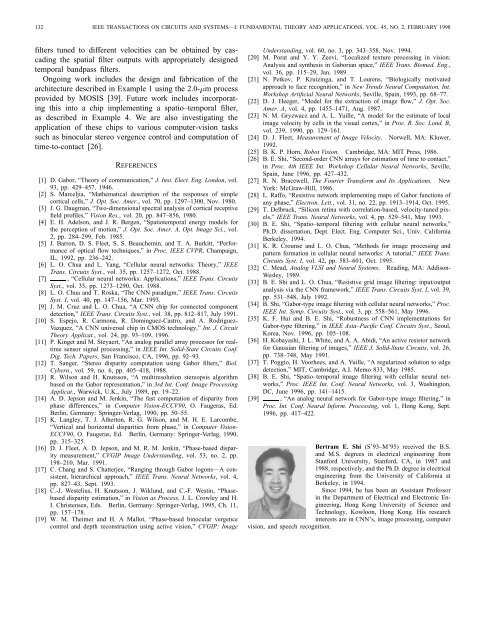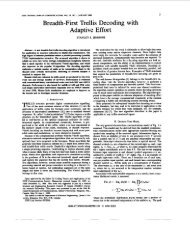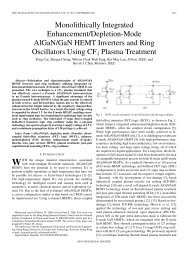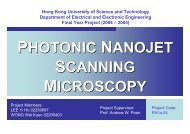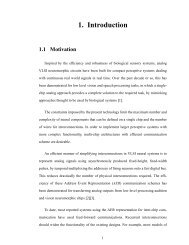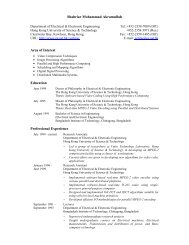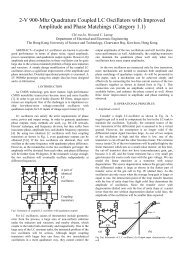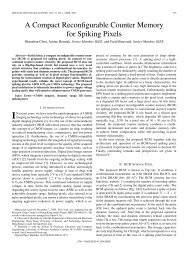Gabor-Type Filtering in Space and Time - Department of Electronic ...
Gabor-Type Filtering in Space and Time - Department of Electronic ...
Gabor-Type Filtering in Space and Time - Department of Electronic ...
Create successful ePaper yourself
Turn your PDF publications into a flip-book with our unique Google optimized e-Paper software.
132 IEEE TRANSACTIONS ON CIRCUITS AND SYSTEMS—I: FUNDAMENTAL THEORY AND APPLICATIONS, VOL. 45, NO. 2, FEBRUARY 1998filters tuned to different velocities can be obta<strong>in</strong>ed by cascad<strong>in</strong>gthe spatial filter outputs with appropriately designedtemporal b<strong>and</strong>pass filters.Ongo<strong>in</strong>g work <strong>in</strong>cludes the design <strong>and</strong> fabrication <strong>of</strong> thearchitecture described <strong>in</strong> Example 1 us<strong>in</strong>g the 2.0- m processprovided by MOSIS [39]. Future work <strong>in</strong>cludes <strong>in</strong>corporat<strong>in</strong>gthis <strong>in</strong>to a chip implement<strong>in</strong>g a spatio–temporal filter,as described <strong>in</strong> Example 4. We are also <strong>in</strong>vestigat<strong>in</strong>g theapplication <strong>of</strong> these chips to various computer-vision taskssuch as b<strong>in</strong>ocular stereo vergence control <strong>and</strong> computation <strong>of</strong>time-to-contact [26].REFERENCES[1] D. <strong>Gabor</strong>, “Theory <strong>of</strong> communication,” J. Inst. Elect. Eng. London, vol.93, pp. 429–457, 1946.[2] S. Marceljia, “Mathematical description <strong>of</strong> the responses <strong>of</strong> simplecortical cells,” J. Opt. Soc. Amer., vol. 70, pp. 1297–1300, Nov. 1980.[3] J. G. Daugman, “Two-dimensional spectral analysis <strong>of</strong> cortical receptivefield pr<strong>of</strong>iles,” Vision Res., vol. 20, pp. 847–856, 1980.[4] E. H. Adelson, <strong>and</strong> J. R. Bergen, “Spatiotemporal energy models forthe perception <strong>of</strong> motion,” J. Opt. Soc. Amer. A, Opt. Image Sci., vol.2, pp. 284–299, Feb. 1985.[5] J. Barron, D. S. Fleet, S. S. Beauchem<strong>in</strong>, <strong>and</strong> T. A. Burkitt, “Performance<strong>of</strong> optical flow techniques,” <strong>in</strong> Proc. IEEE CVPR, Champaign,IL, 1992, pp. 236–242.[6] L. O. Chua <strong>and</strong> L. Yang, “Cellular neural networks: Theory,” IEEETrans. Circuits Syst., vol. 35, pp. 1257–1272, Oct. 1988.[7] , “Cellular neural networks: Applications,” IEEE Trans. CircuitsSyst., vol. 35, pp. 1273–1290, Oct. 1988.[8] L. O. Chua <strong>and</strong> T. Roska, “The CNN paradigm,” IEEE Trans. CircuitsSyst. I, vol. 40, pp. 147–156, Mar. 1993.[9] J. M. Cruz <strong>and</strong> L. O. Chua, “A CNN chip for connected componentdetection,” IEEE Trans. Circuits Syst., vol. 38, pp. 812–817, July 1991.[10] S. Espejo, R. Carmona, R. Dom<strong>in</strong>guez-Castro, <strong>and</strong> A. Rodriguez-Vazquez, “A CNN universal chip <strong>in</strong> CMOS technology,” Int. J. CircuitTheory Applicat., vol. 24, pp. 93–109, 1996.[11] P. K<strong>in</strong>get <strong>and</strong> M. Steyaert, “An analog parallel array processor for realtimesensor signal process<strong>in</strong>g,” <strong>in</strong> IEEE Int. Solid-State Circuits Conf.Dig. Tech. Papers, San Francisco, CA, 1996, pp. 92–93.[12] T. Sanger, “Stereo disparity computation us<strong>in</strong>g <strong>Gabor</strong> filters,” Biol.Cybern., vol. 59, no. 6, pp. 405–418, 1988.[13] R. Wilson <strong>and</strong> H. Knutsson, “A multiresolution stereopsis algorithmbased on the <strong>Gabor</strong> representation,” <strong>in</strong> 3rd Int. Conf. Image Process<strong>in</strong>gApplicat., Warwick, U.K., July 1989, pp. 19–22.[14] A. D. Jepson <strong>and</strong> M. Jenk<strong>in</strong>, “The fast computation <strong>of</strong> disparity fromphase differences,” <strong>in</strong> Computer Vision-ECCV90, O. Faugeras, Ed.Berl<strong>in</strong>, Germany: Spr<strong>in</strong>ger-Verlag, 1990, pp. 50–55.[15] K. Langley, T. J. Atherton, R. G. Wilson, <strong>and</strong> M. H. E. Larcombe,“Vertical <strong>and</strong> horizontal disparities from phase,” <strong>in</strong> Computer Vision-ECCV90, O. Faugeras, Ed. Berl<strong>in</strong>, Germany: Spr<strong>in</strong>ger-Verlag, 1990,pp. 315–325.[16] D. J. Fleet, A. D. Jepson, <strong>and</strong> M. R. M. Jenk<strong>in</strong>, “Phase-based disparitymeasurement,” CVGIP Image Underst<strong>and</strong><strong>in</strong>g, vol. 53, no. 2, pp.198–210, Mar. 1991.[17] C. Chang <strong>and</strong> S. Chatterjee, “Rang<strong>in</strong>g through <strong>Gabor</strong> logons—A consistent,hierarchical approach,” IEEE Trans. Neural Networks, vol. 4,pp. 827–43, Sept. 1993.[18] C.-J. Westelius, H. Knutsson, J. Wiklund, <strong>and</strong> C.-F. West<strong>in</strong>, “Phasebaseddisparity estimation,” <strong>in</strong> Vision as Process, J. L. Crowley <strong>and</strong> H.I. Christensen, Eds. Berl<strong>in</strong>, Germany: Spr<strong>in</strong>ger-Verlag, 1995, Ch. 11,pp. 157–178.[19] W. M. Theimer <strong>and</strong> H. A Mallot, “Phase-based b<strong>in</strong>ocular vergencecontrol <strong>and</strong> depth reconstruction us<strong>in</strong>g active vision,” CVGIP: ImageUnderst<strong>and</strong><strong>in</strong>g, vol. 60, no. 3, pp. 343–358, Nov. 1994.[20] M. Porat <strong>and</strong> Y. Y. Zeevi, “Localized texture process<strong>in</strong>g <strong>in</strong> vision:Analysis <strong>and</strong> synthesis <strong>in</strong> <strong>Gabor</strong>ian space,” IEEE Trans. Biomed. Eng.,vol. 36, pp. 115–29, Jan. 1989.[21] N. Petkov, P. Kruiz<strong>in</strong>ga, <strong>and</strong> T. Lourens, “Biologically motivatedapproach to face recognition,” <strong>in</strong> New Trends Neural Computation, Int.Workshop Artificial Neural Networks, Seville, Spa<strong>in</strong>, 1993, pp. 68–77.[22] D. J. Heeger, “Model for the extraction <strong>of</strong> image flow,” J. Opt. Soc.Amer. A, vol. 4, pp. 1455–1471, Aug. 1987.[23] N. M. Gryzwacz <strong>and</strong> A. L. Yuille, “A model for the estimate <strong>of</strong> localimage velocity by cells <strong>in</strong> the visual cortex,” <strong>in</strong> Proc. R. Soc. Lond. B,vol. 239, 1990, pp. 129–161.[24] D. J. Fleet, Measurement <strong>of</strong> Image Velocity. Norwell, MA: Kluwer,1992.[25] B. K. P. Horn, Robot Vision. Cambridge, MA: MIT Press, 1986.[26] B. E. Shi, “Second-order CNN arrays for estimation <strong>of</strong> time to contact,”<strong>in</strong> Proc. 4th IEEE Int. Workshop Cellular Neural Networks, Seville,Spa<strong>in</strong>, June 1996, pp. 427–432.[27] R. N. Bracewell, The Fourier Transform <strong>and</strong> Its Applications. NewYork: McGraw-Hill, 1986.[28] L. Raffo, “Resistive network implement<strong>in</strong>g maps <strong>of</strong> <strong>Gabor</strong> functions <strong>of</strong>any phase,” Electron. Lett., vol. 31, no. 22, pp. 1913–1914, Oct. 1995.[29] T. Delbruck, “Silicon ret<strong>in</strong>a with correlation-based, velocity-tuned pixels,”IEEE Trans. Neural Networks, vol. 4, pp. 529–541, May 1993.[30] B. E. Shi, “Spatio–temporal filter<strong>in</strong>g with cellular neural networks,”Ph.D. dissertation, Dept. Elect. Eng. Computer Sci., Univ. CaliforniaBerkeley, 1994.[31] K. R. Crounse <strong>and</strong> L. O. Chua, “Methods for image process<strong>in</strong>g <strong>and</strong>pattern formation <strong>in</strong> cellular neural networks: A tutorial,” IEEE Trans.Circuits Syst. I, vol. 42, pp. 583–601, Oct. 1995.[32] C. Mead, Analog VLSI <strong>and</strong> Neural Systems. Read<strong>in</strong>g, MA: Addison-Wesley, 1989.[33] B. E. Shi <strong>and</strong> L. O. Chua, “Resistive grid image filter<strong>in</strong>g: <strong>in</strong>put/outputanalysis via the CNN framework,” IEEE Trans. Circuits Syst. I, vol. 39,pp. 531–548, July 1992.[34] B. Shi, “<strong>Gabor</strong>-type image filter<strong>in</strong>g with cellular neural networks,” Proc.IEEE Int. Symp. Circuits Syst., vol. 3, pp. 558–561, May 1996.[35] K. F. Hui <strong>and</strong> B. E. Shi, “Robustness <strong>of</strong> CNN implementations for<strong>Gabor</strong>-type filter<strong>in</strong>g,” <strong>in</strong> IEEE Asia–Pacific Conf. Circuits Syst., Seoul,Korea, Nov. 1996, pp. 105–108.[36] H. Kobayashi, J. L. White, <strong>and</strong> A. A. Abidi, “An active resistor networkfor Gaussian filter<strong>in</strong>g <strong>of</strong> images,” IEEE J. Solid-State Circuits, vol. 26,pp. 738–748, May 1991.[37] T. Poggio, H. Voorhees, <strong>and</strong> A. Yuille, “A regularized solution to edgedetection,” MIT, Cambridge, A.I. Memo 833, May 1985.[38] B. E. Shi, “Spatio–temporal image filter<strong>in</strong>g with cellular neural networks,”Proc. IEEE Int. Conf. Neural Networks, vol. 3, Wash<strong>in</strong>gton,DC, June 1996, pp. 141–1415.[39] , “An analog neural network for <strong>Gabor</strong>-type image filter<strong>in</strong>g,” <strong>in</strong>Proc. Int. Conf. Neural Inform. Process<strong>in</strong>g, vol. 1, Hong Kong, Sept.1996, pp. 417–422.Bertram E. Shi (S’93–M’95) received the B.S.<strong>and</strong> M.S. degrees <strong>in</strong> electrical eng<strong>in</strong>eer<strong>in</strong>g fromStanford University, Stanford, CA, <strong>in</strong> 1987 <strong>and</strong>1988, respectively, <strong>and</strong> the Ph.D. degree <strong>in</strong> electricaleng<strong>in</strong>eer<strong>in</strong>g from the University <strong>of</strong> California atBerkeley, <strong>in</strong> 1994.S<strong>in</strong>ce 1994, he has been an Assistant Pr<strong>of</strong>essor<strong>in</strong> the <strong>Department</strong> <strong>of</strong> Electrical <strong>and</strong> <strong>Electronic</strong> Eng<strong>in</strong>eer<strong>in</strong>g,Hong Kong University <strong>of</strong> Science <strong>and</strong>Technology, Kowloon, Hong Kong. His research<strong>in</strong>terests are <strong>in</strong> CNN’s, image process<strong>in</strong>g, computervision, <strong>and</strong> speech recognition.


